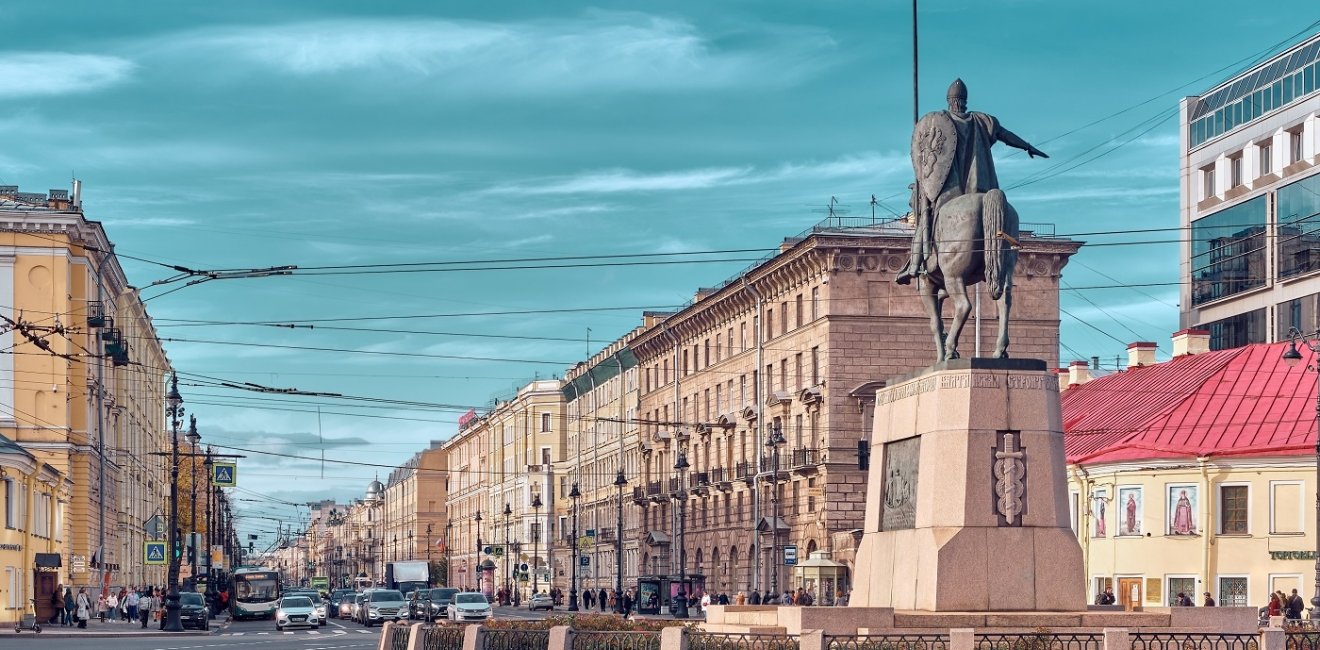
A blog of the Kennan Institute
Russia’s so-called “special military operation” has a neo-imperial twist to it. For the insatiable Russia, occupation of the land does not suffice: the largest country in the world is attempting to occupy mental spaces as well and to impose a new master narrative of Great Mother Russia. How? Through mythmaking, combined with the Nietzschean “use and abuse of history.”
In September 2022, Alexander Beglov, the governor of St. Petersburg, visited the war-ravaged Ukrainian city of Mariupol, currently occupied by Putin’s Russia. Previously, Vladimir Putin had tasked Beglov, as well as the whole city of St. Petersburg, with taking charge of Mariupol’s rebuilding and restoration. In the devastated city, which stands as a gruesome symbol of Russian brutality, Beglov unveiled a newly erected statue to Alexander Nevsky, a prince of medieval Rus’ and a saint of the Russian Orthodox Church.
What does a thirteenth-century prince, famous for defeating German and Swedish invaders in northern Russian lands, have to do with the war-torn Ukrainian city of Mariupol on the Sea of Azov? His uninvited commemoration in Ukraine is not just a statue, it is an ideological statement.
The Historical Alexander Nevsky
Alexander was born the son of Yaroslav II, grand prince of Vladimir, then the most powerful principality of Russia. In 1236, Alexander was invited by the people of Novgorod to become their prince. In 1240, he defeated the invading Swedish forces at the confluence of the rivers Izhora and Neva. The victory at the Neva river, the signature waterway of St. Petersburg, gave Alexander his moniker—Nevsky.
His next military success came in repelling the Germanic Teutonic Knights, sent by the pope as a part of the Northern Crusades. In the Battle on the Ice, on the frozen Lake Chudskoye (Lake Peipus), which would determine whether Eastern Orthodox or Western Catholic Christianity would take primacy in the region, Alexander defeated the Germans, who then stopped their eastward expansion.
Nevsky was also a politician of his time. He collaborated with the Mongol conquerors by assisting them in their tax demands, going so far as to force rebellious Novgorod to submit to the yoke. Nevsky’s military successes, celebrated in Russia as the victory of Orthodox Christianity over Catholicism, eventually led to his canonization by the Russian Orthodox Church in 1547.
While Alexander Nevsky was venerated as a saint, his accession to national hero began during the rule of Peter the Great, the first Russian emperor. As Russia, in alliance with Denmark-Norway and Saxony-Poland, fought the Great Northern War (1700–1721) against the Swedish Empire for dominance over the Baltic region, Peter the Great saw a lot in common between Alexander and himself. Peter sought to support his political and military strategy claims with historical justifications. After the victory over the Swedes in the Great Northern War, Peter ordered Alexander’s relics be transferred to Russia’s new imperial capital, St. Petersburg, a newly built city on the Neva.
Stalin’s Alexander
After the Bolsheviks seized power in 1917 and eventually established the Soviet Union, they sought to depart from the pre-revolutionary national heroic lore, following the ideology of proletarian internationalism, which called for solidarity between international workers, with the eventual goal of global revolution. However, with Stalin’s consolidation of power in the 1930s, he turned the state ideology toward Russian national patriotism, or, as some historians have called it, National Bolshevism. The great Russian heroes of the past became relevant again, and Soviet propaganda effectively used them to boost a russocentric patriotism.
In 1938, acclaimed director Sergei Eisenstein directed the epic historical film Alexander Nevsky. The film, centered on the Battle on the Ice and featuring a gruesome scene of German Knights murdering Russian babies, achieved great success both domestically and internationally. Banned in the Soviet Union for two years after the Molotov-Ribbentrop Pact, the film, along with its namesake prince, became especially popular after the beginning of the Nazi invasion of the USSR in 1941. Attempting to mobilize the nation, Stalin and his propagandists appealed to the heroic past and the perceived greatness of the Russian pre-revolutionary military history.
In the contemporary history of the Russian Federation, Alexander Nevsky retains his popularity and importance. In 2008, he was named the main hero of Russia’s history, winning the popular voting contest run by a television channel. The victory of the beloved character was clouded by widespread rumors that it was Joseph Stalin who was supposed to have won. (The dictator had led at the start of the the contest.) .
Nevsky also became an important figure in the ranks of the Russian nationalist organizations. In 1996, the controversial Russian National Bolshevik Party, cofounded by author and activist Eduard Limonov and political thinker Alexander Dugin, suggested an annual celebration of the Day of the Russian Nation on April 5, the anniversary of the Battle on the Ice. While the holiday never became official, various nationalist and patriotic organizations have developed a tradition of celebrating the day.
Putin’s Alexander
In September 2022, Igor Girkin (Strelkov), former FSB officer, ex-minister of defense of the so-called “Donetsk People’s Republic,” and an instrumental figure at the beginning the Donbas conflict in 2014, who is wanted in the Netherlands for the downing of flight MH17 on July 14, 2014, announced that his nationalist movement, Novorossiya, was backing the formation of the all-volunteer battalion tactical group to support the Russian invasion of Ukraine. The group was named “Nevsky” and its insignia feature the image of the prince. The St. Petersburg archdiocese blessed the group and gifted it an icon of Alexander Nevsky.
Nationalist groups are not the only ones who turn their attention to Nevsky. During the course of Russia’s invasion of Ukraine, Putin’s propagandists, who routinely employ the narratives of Russia’s “great past”, have strengthened their emphasis on the eternal conflict between Russia and the West. Kremlin-issued recommendations for the mass media offer direct comparisons between Alexander Nevsky and Vladimir Putin, between the current war and Nevsky’s battle against Sweden. According to this paradigm, Russia fights against the “Collective West”—the historical adversary of Russia, which in various times was represented by the Teutonic Knights, Sweden, Napoleon, and Nazi Germany.
When Beglov presented the statue of Alexander Nevsky in war-torn Mariupol, he remarked that Nevsky fought enemies from the same countries Russia is fighting now. While factually absurd, his words echo Putin’s hatred and fear of the West and the nationalist ideology that has become mainstream in contemporary Russia. The current war of Russian aggression against Ukraine is presented as an existential war that Putin started out of necessity to avoid the inevitable Western invasion. In this paradigm, the medieval prince who fought the Western invaders and was reanimated by Stalin in the war against the Germans is repurposed once again by Putin and the Russian nationalists, who view the war against Ukraine as a continuation of the eternal battle against the West.
The opinions expressed in this article are those solely of the authors and do not reflect the views of the Kennan Institute.
Authors


Kennan Institute
After more than 50 years as a vital part of the Wilson Center legacy, the Kennan Institute has become an independent think tank. You can find the current website for the Kennan Institute at kennaninstitute.org. Please look for future announcements about partnership activities between the Wilson Center and the Kennan Institute at Wilson Center Press Room. The Kennan Institute is the premier US center for advanced research on Eurasia and the oldest and largest regional program at the Woodrow Wilson International Center for Scholars. The Kennan Institute is committed to improving American understanding of Russia, Ukraine, Central Asia, the South Caucasus, and the surrounding region through research and exchange. Read more

Explore More in The Russia File
Browse The Russia File
Chechnya as a Model of Modern Russia

Russia’s Indigenous Communities and the War in Ukraine

Gas and Power in a Changing US–Russia Relationship

